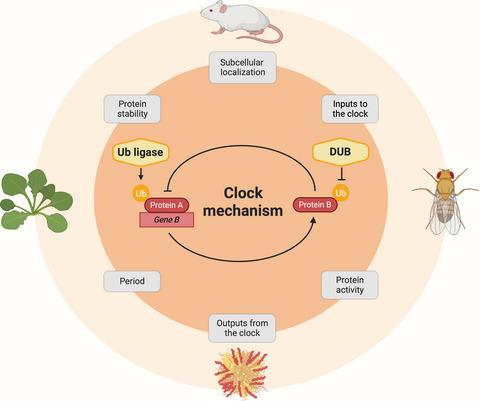当前位置:
X-MOL 学术
›
J. Neurochem.
›
论文详情
Our official English website, www.x-mol.net, welcomes your
feedback! (Note: you will need to create a separate account there.)
To Ub or not to Ub: Regulation of circadian clocks by ubiquitination and deubiquitination
Journal of Neurochemistry ( IF 4.2 ) Pub Date : 2020-07-27 , DOI: 10.1111/jnc.15132 Shashank Bangalore Srikanta 1, 2 , Nicolas Cermakian 2, 3
Journal of Neurochemistry ( IF 4.2 ) Pub Date : 2020-07-27 , DOI: 10.1111/jnc.15132 Shashank Bangalore Srikanta 1, 2 , Nicolas Cermakian 2, 3
Affiliation

|
Circadian clocks are internal timing systems that enable organisms to adjust their behavioral and physiological rhythms to the daily changes of their environment. These clocks generate self‐sustained oscillations at the cellular, tissue, and behavioral level. The rhythm‐generating mechanism is based on a gene expression network with a delayed negative feedback loop that causes the transcripts to oscillate with a period of approximately 24 hr. This oscillatory nature of the proteins involved in this network necessitates that they are intrinsically unstable, with a short half‐life. Hence, post‐translational modifications (PTMs) are important to precisely time the presence, absence, and interactions of these proteins at appropriate times of the day. Ubiquitination and deubiquitination are counter‐balancing PTMs which play a key role in this regulatory process. In this review, we take a comprehensive look at the roles played by the processes of ubiquitination and deubiquitination in the clock machinery of the most commonly studied eukaryotic models of the circadian clock: plants, fungi, fruit flies, and mammals. We present the effects exerted by ubiquitinating and deubiquitinating enzymes on the stability, but also the activity, localization, and interactions of clock proteins. Overall, these PTMs have key roles in regulating not only the pace of the circadian clocks but also their response to external cues and their control of cellular functions.
中文翻译:

对Ub或不对Ub:通过泛素化和去泛素化调节生物钟
昼夜节律钟是内部计时系统,使生物能够根据环境的日常变化调整其行为和生理节律。这些时钟在细胞,组织和行为水平上产生自我维持的振荡。节奏产生机制是基于带有延迟负反馈回路的基因表达网络,该回路会导致转录本振荡大约24小时。该网络中涉及的蛋白质的这种振荡性质使得它们本质上是不稳定的,半衰期很短。因此,翻译后修饰(PTM)对于精确计时这些蛋白质在一天中的适当时间的存在,不存在和相互作用非常重要。泛素化和去泛素化是平衡PTM的手段,在此监管过程中发挥着关键作用。在这篇综述中,我们全面研究了生物钟最常研究的真核生物模型:植物,真菌,果蝇和哺乳动物中,泛素化和去泛素化过程所起的作用。我们介绍了泛素化和去泛素化酶对稳定性的影响,以及时钟蛋白的活性,定位和相互作用。总体而言,这些PTM不仅在调节生物钟的节奏方面而且在调节其对外部线索的反应以及控制细胞功能方面都起着关键作用。我们将全面研究生物钟最常研究的真核生物模型:植物,真菌,果蝇和哺乳动物在生物钟机制中泛素化和去泛素化过程所起的作用。我们介绍了泛素化和去泛素化酶对稳定性的影响,以及时钟蛋白的活性,定位和相互作用。总体而言,这些PTM不仅在调节生物钟的节奏方面而且在调节其对外部线索的反应以及控制细胞功能方面都起着关键作用。我们将全面研究生物钟最常研究的真核生物模型:植物,真菌,果蝇和哺乳动物在生物钟机制中泛素化和去泛素化过程所起的作用。我们介绍了泛素化和去泛素化酶对稳定性的影响,以及时钟蛋白的活性,定位和相互作用。总体而言,这些PTM不仅在调节生物钟的节奏方面而且在调节其对外部线索的反应以及控制细胞功能方面都起着关键作用。和时钟蛋白的相互作用。总体而言,这些PTM不仅在调节生物钟的节奏方面而且在调节其对外部线索的反应以及控制细胞功能方面都起着关键作用。和时钟蛋白的相互作用。总体而言,这些PTM不仅在调节生物钟的节奏方面而且在调节其对外部线索的反应以及控制细胞功能方面都起着关键作用。
更新日期:2020-07-27
中文翻译:

对Ub或不对Ub:通过泛素化和去泛素化调节生物钟
昼夜节律钟是内部计时系统,使生物能够根据环境的日常变化调整其行为和生理节律。这些时钟在细胞,组织和行为水平上产生自我维持的振荡。节奏产生机制是基于带有延迟负反馈回路的基因表达网络,该回路会导致转录本振荡大约24小时。该网络中涉及的蛋白质的这种振荡性质使得它们本质上是不稳定的,半衰期很短。因此,翻译后修饰(PTM)对于精确计时这些蛋白质在一天中的适当时间的存在,不存在和相互作用非常重要。泛素化和去泛素化是平衡PTM的手段,在此监管过程中发挥着关键作用。在这篇综述中,我们全面研究了生物钟最常研究的真核生物模型:植物,真菌,果蝇和哺乳动物中,泛素化和去泛素化过程所起的作用。我们介绍了泛素化和去泛素化酶对稳定性的影响,以及时钟蛋白的活性,定位和相互作用。总体而言,这些PTM不仅在调节生物钟的节奏方面而且在调节其对外部线索的反应以及控制细胞功能方面都起着关键作用。我们将全面研究生物钟最常研究的真核生物模型:植物,真菌,果蝇和哺乳动物在生物钟机制中泛素化和去泛素化过程所起的作用。我们介绍了泛素化和去泛素化酶对稳定性的影响,以及时钟蛋白的活性,定位和相互作用。总体而言,这些PTM不仅在调节生物钟的节奏方面而且在调节其对外部线索的反应以及控制细胞功能方面都起着关键作用。我们将全面研究生物钟最常研究的真核生物模型:植物,真菌,果蝇和哺乳动物在生物钟机制中泛素化和去泛素化过程所起的作用。我们介绍了泛素化和去泛素化酶对稳定性的影响,以及时钟蛋白的活性,定位和相互作用。总体而言,这些PTM不仅在调节生物钟的节奏方面而且在调节其对外部线索的反应以及控制细胞功能方面都起着关键作用。和时钟蛋白的相互作用。总体而言,这些PTM不仅在调节生物钟的节奏方面而且在调节其对外部线索的反应以及控制细胞功能方面都起着关键作用。和时钟蛋白的相互作用。总体而言,这些PTM不仅在调节生物钟的节奏方面而且在调节其对外部线索的反应以及控制细胞功能方面都起着关键作用。











































 京公网安备 11010802027423号
京公网安备 11010802027423号